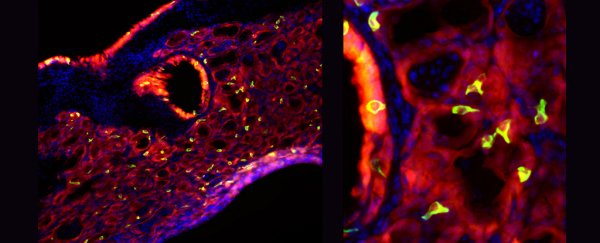Chemosensory 'taste' cells resembling those on the tongue have been discovered growing in the lungs of mice recovering from a severe flu infection.
The discovery of these cells - also known as tuft cells - growing in lung tissue after an infection not only helps us understand the purpose of these odd little tasters, it might help explain why a single dose of influenza can compromise our health for life.
Researchers from the University of Pennsylvania in the US were curious about how lungs can repair themselves following injury from disease. Of particular interest was how the tissue structure itself seems to change post-infection.
Most of us will recover from a bad case of influenza given enough time, eventually returning to a level of health we enjoyed before we became bed-ridden for a few weeks.
An unlucky few will literally be changed for life, their lungs permanently 'scarred' by a change in tissue structure we're still struggling to understand. The consequences are a litany of physiological and psychological complications for many years to come.
Several years ago, the researchers noticed that the change in lung tissue makeup was accompanied by inflammation that refused to vanish, even after all other signs of infection had faded.
In a follow-up study, the team aimed to uncover the cause of this mysterious swelling.
By infecting mice with influenza H1N1 and studying samples of their lung tissue over the following weeks, the team found the chemical signals they were producing weren't the usual Type 1 variety associated with invading viruses.
Instead, they were indicative of a Type 2 reaction - the immune response that usually helps combat the kinds of threats that don't tend to push their way inside cells, such as allergens and parasites.
"These hallmarks of a Type 2 immune response after flu were unexpected, and have gone largely unnoticed until very recently," says biologist Andrew Vaughan.
All signs were pointing to the presence of a strange cell with an unruly haircut.
Tuft cells can be found all through our digestive system, nestled in the epithelial lining with their mop of microvilli projecting out into the cavernous gut.
First observed more than half a century ago, for a while they baffled scientists with their ubiquitous presence and mysterious role.
On the one hand, these pear-shaped epithelial cells closely resemble cells found in taste buds, complete with receptors that respond to the presence of the sorts of chemical compounds we associate with bitter and sweet flavours.
But they were soon found not just in the intestine, but in a wide range of linings, from the inner walls of the trachea to those of the urethra.
A logical assumption would be their talent for tasting was being employed in a range of places, but until recently their job description hasn't been all that clear.
Clues have pointed to an immune response. A separate study published recently conducted by a team from the College of Life Sciences in China further nailed down the tuft cell's mechanisms in protecting against infestations of the nematode parasite Trichinella spiralis.
Noticing a Type 2 red flag, the Pennsylvania University researchers went on the hunt for those suspicious tuft cells in the alveoli air sacs inside mouse lungs. And they weren't disappointed.
"It was just really weird to see, because these cells are not in the lung at baseline," says Vaughan.
"The closest they are normally is in the trachea. What we did was show where they're coming from and how this same rare cell type that gives you all this maladaptive remodelling of the lung after flu is also the source of these ectopic tuft cells."
To see if those 'taste' cells were chemically responsive, the team tried to activate them with a dose of bitter compounds. Not only did the cells respond by expanding, they kicked off an acute episode of inflammation.
None of this happened in mouse lungs that hadn't suffered a bout of the flu.
The next steps will include finding exactly what impact their presence has on the lung's ability to heal after an infection, and hunting for the same spontaneous appearance of tuft-cells in human lung tissue.
The fact tuft cells have also been noticed in the lungs of asthmatics and in nasal polyps might also fill in the gaps on Type 2 immune responses and how an infection can lead to a lifelong disorder.
So much is yet to be discovered about these mediators of taste and immunity. But given what has been found so far, they could hold the key to preventing, or even treating, a variety of health conditions in the future.
This research was published in the American Journal of Physiology - Lung Cellular and Molecular Physiology.
